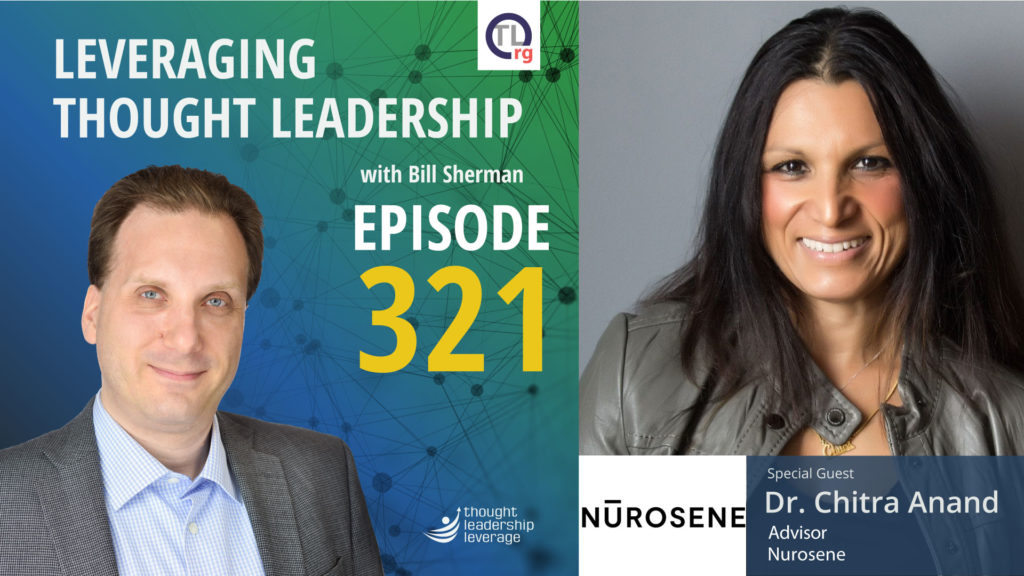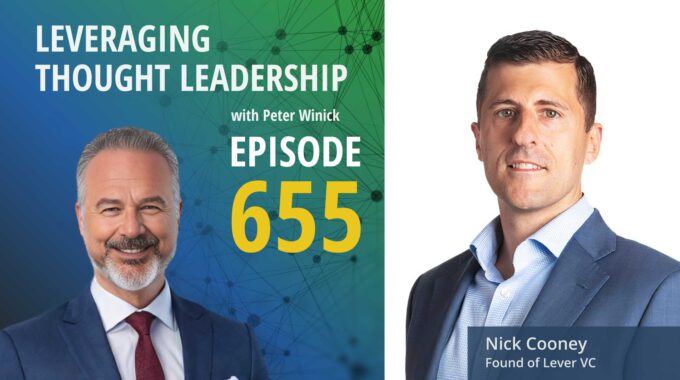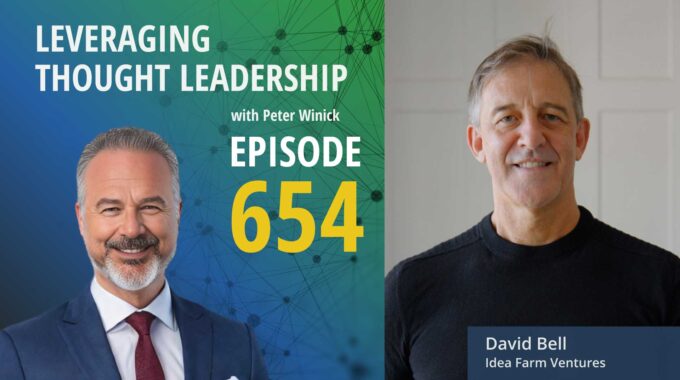How Strategic Content Fuels Growth in Purpose-Led Ventures This episode explores how thought leadership can…
Thought Leadership in Private Equity and Intrapreneurship | Dr. Chitra Anand

How thought leadership can reach beyond content marketing in untypical industries.
An interview with Dr. Chitra Anand about the role of intrapreneurs in the workplace and using thought leadership over content marketing.
If you’ve ever felt creatively “stuck in a rut,” and innovation seems out of reach, this is the episode to cure your woes!
Our guest today is Dr. Chitra Anand, an award-winning Communications & Marketing executive with over 20 years in the technology industry. She’s an extraordinary leader, and has spent time as the head of Communications for Microsoft Canada, Director of Marketing at TELUS Corporation, and Director of Operations at Open Tex. She is also the author of The Green House Approach, a book filled with insights about innovation, creating compelling storytelling in business, and fighting complacency in the workplace. The Green House Approach is a mindset shift; a change in the way we approach thinking, and gives strong advice about “breaking out” and challenging current structural norms.
Bill and Chitra reminisce about her career in various tech companies, and discuss the way she implemented thought leadership to educate customers about new trends – long before “thought leadership” was a commonly used term! Plus, Chitra illuminates the many contrasts between content marketing and thought leadership, and how your organization needs both if you’re going to thrive.
Chitra is leading a new movement in the workplace: Intrapreneurship! Today, she tells us what the term means, and how Intrapreneurship can drive innovative thinking and build new, better ways of conducting business. Chitra gives thoughtful advice for those looking to include “Intrapreneurship” in their organization. This is a great episode, sure to change your mindset and leave you with great ideas. Give it a listen!
Three Key Takeaways
- Thought leadership means building new ideas and concepts; content marketing means leveraging an existing product or service.
- Thought leadership that forces clients to question old, staid habits, and identify behavioral shifts that can move an organization forward.
- Good thought leadership creates trust, and trust builds business.
Join the Organizational Thought Leadership Newsletter to learn more about expanding thought leadership within your organization! This monthly newsletter is full of practical information, advice, and ideas to help you reach your organization’s thought leadership goals.
And if you need help scaling organizational thought leadership, contact Thought Leadership Leverage!
Transcript:
Bill Sherman Where does thought leadership fit within the worlds of technology and entrepreneurship? Today, to investigate that question, I sit down with Dr. Chitra Anand. Over her career, she’s been a head of communications for tech giants like Microsoft and also an advisor to startups. She specializes in the role of the entrepreneur, a role which aligns closely with thought leadership. I’m Bill Sherman and this is Leveraging Thought Leadership. Ready? Let’s begin. So welcome to the show, Chitra.
Chitra Anand Thank you for having me. So nice to be here.
Bill Sherman So this is a conversation where we’re going to talk about thought leadership from several different perspectives. We’re going to talk about it from entrepreneurship, which I know is a topic that you’re deeply passionate about. We’ll talk about marketing. And also I want to explore also one of the projects you’re working on, which is private equity. So let’s start with the simple question, how do you define thought leadership?
Chitra Anand Yeah, it’s a great question, Bill, and from my perspective, thought leadership I believe is the greatest form of competitive differentiation right now for marketers. I would define it as deliberate content that really takes a outside and perspective on social issues, cultural issues that really ties and leverages the talents and experiences and passions within your business.
Bill Sherman With that, you come from a marketing background, right?
Chitra Anand I do.
Bill Sherman So tell us a little bit about your background and how your road led to fall leadership.
Chitra Anand Well, it’s interesting, because I’ve been in the technology industry for twenty five years, and I believe that thought leadership has now. It’s been coined as a term, and in the past, companies may or may not have been doing it without actually realizing it. So, for example, you know, I had a great career at Telus. I spent over 10 years at Telus, which is sort of the equivalent of a Verizon in the U.S. and I was there right when the social spectrum sort of blew up and we were looking at all these new social platforms, media platforms. But we very intuitively knew that people needed engaging content and we wanted to be a form of education to our customers, to our partners. And so we created namesake content, whether it was editorial content, whether it was workshops, talks, and we really educated our customers around the new trends and technologies that were really transformative up during that time. You know, similarly, when I when I then went over to Microsoft, you know, thought leadership was starting to become a thing. But you know, one of the things that I did there was ensured that we have this ongoing cadence of content. And so and it was a very deliberate move to really have this, this always on cadence on what was happening in the market. So an editorial piece that was tied to something that was happening, you know, based on a calendar year, what was happening from a from a business perspective in the markets, we created a little bit of a 10x series where we had some thought leaders come together talking about certain issues, opportunities as it relates to entrepreneurship within Canada. And we did that in a very deliberate way. So when I was in both of those roles, the thought leadership piece was always this byproduct of the work that I did as a marketer there.
Bill Sherman So let’s dive in a little bit further on that. So this intersection between thought, leadership, marketing, building, relationships, you’ve talked about content. And I think when a lot of marketers talk about content, it leads to content marketing distinguish for me, if you will. What’s the difference between content marketing in your perspective and how it’s used versus thought leadership?
Chitra Anand I mean, it’s a great point. I think part leadership is more insight is led by research and insights. When we think about content marketing. Some of my observations in the market has been leveraging your product or services within that form of marketing, so there’s a tie to your product or service. What leadership is it is outside of that realm where it’s really deeply rooted in insight and research. So, for example, you know, one of the pieces that I’ve written when I was at Microsoft was really around what are the macro trends that are happening in Canada around the small, medium business space and not related to Microsoft? But what are the technologies that are driving entrepreneurial companies in our country and why our eyes on Canada as the new Silicon Valley? So that was more about insight driven piece of work. Whereas in the past, you know, tried to get away from content marketing, some of the pieces of content marketing was how can a product or service, whether it’s at Telus or Microsoft, really help drive an issue forward or solve a problem, et cetera. So when you have more of a product centric view of the firm in the piece of marketing, what leadership is more around a topic that is namesake or a macro trend that’s happening in markets where there’s a particular insight?
Bill Sherman And I think this distinction is one content marketing is very much tied to the sales pipeline and to identifying who’s a prospective buyer and how do you get them through, you know, marketing qualified lead sales, qualified lead to close deal, whereas with thought leadership, you may have a sale or an offer in mind. But it’s a much different relationship and a much different time horizon, and I like the distinction that you make there. Now let’s let’s talk about time horizon from a different perspective because you’ve taken a role for thought leadership tied to private equity. And when I first saw your bio, I was surprised by that because I said, OK, private equity and thought leadership. How are these two going together? So let’s start there.
Chitra Anand Well, that’s interesting. Yes. So I was part of a firm called Mavericks, where I was reading their branding marketing for leadership. And I mean, your point is really quite interesting because you don’t see a lot of private equity firms investing in a CMO or that type of role. But here’s my observation. When you’re meeting with portfolio companies, and so aside from the firm itself. The greatest opportunity that I see these growth companies have is really around. How are they packaging their companies and so what I mean by that, it’s more than just brand positioning, but what they can offer is an opportunity to really tell an integrated narrative. And I think there’s a lot of there’s a lot of opportunity there. But from a firm perspective, I think what these firms are after is as much as they are there to return shareholder value and create success for their investors. They’re starting to think about, well, how can we be leaders and how can we differentiate ourselves in a more meaningful way through insights and research around particular topics? And those topics can be tied to various industries, various verticals, etc. So I think there’s great opportunity there. You know, one of the things I just observe, Bill was Bessemer Venture has just hired a CMO, and that very role is really around cultivating leadership. And so, you know, we talked about earlier how leadership or content marketing really drives the pipeline in terms of sales. But what I think the thought leadership really does is it creates trust. And when you have trust, that’s when people want to do business with you. So you’re competing with companies wanting to do business with you and customers. And so what happens is the rate of acquisition for customers increases through these deliberate efforts, and those were my biggest observations there.
Bill Sherman And I think that acquisition piece is important in terms of trust and accelerating the rate. Let’s. Let’s think on this for a second here in. The world of private equity and identifying firms, which ones they’re going to bring in to the portfolio versus which ones they pass on the deal. Where is there a space for looking at either the presence or absence of thought leadership during due diligence?
Chitra Anand That’s a great question. I think that’s an important question. It really it really depends on. The maturity and the thinking of the firm. Right. And what I mean by that is most of these companies are in a growth trajectory. They want to grow, they want to scale, they want to accelerate because that’s how these companies are really, truly successful. Now,.
Bill Sherman Well, you’re talking specifically Tech private equity rather than – which is a subset.
Chitra Anand Well, I mean, that’s interesting. I am. But it doesn’t necessarily have to be because even if you have a consumer based product, for example, you can still have a voice within the thought leadership spectrum and have some interesting content. That’s engaging because people always want to engage with meaningful content, regardless of what industry you’re in or whatever, whatever it is that you’re doing. It’s really about engaging content. So, yes, tech based. However, I think just coming out of what’s happening in the global pandemic and you’re seeing all of these startups and you’re seeing all these companies that are being born out of the pandemic, people want to engage with companies. And how do you engage? You can engage with them through content with really meaningful content and not content marketing. But these thought leadership pieces, because people want to be challenged, they want to learn, they want insights, they want. They want things that are rooted in something. And that’s what part leadership provides. It’s a deeper it’s a deeper look at that certain topics and at things that are happening at our world. And really, quite frankly, it gives it draws a direct line into how the company operates. You know, one of the things that they care about, how are they governing? They’re their own business. And I think that it plays into a bit of the culture of the organization because I do believe that culture dictates business. And so it’s a cultural fabric and a culture component. It really helps shape the way firms are thinking.
Bill Sherman If you are enjoying this episode of Leveraging Thought Leadership, please make sure to subscribe. If you’d like to help spread the word about the podcast, please leave a five star review and share it with your friends. We are available on Apple Podcasts, Spotify and all major platforms, as well as at Leveraging Thought Leadership dot com.
Bill Sherman With that, you’ve talked about the ability to tell the story better. And I think from a PR perspective, when you’re looking and saying, where is their value? That’s not captured? If you’re a manufacturing firm, you can go, OK, do we bring in new manufacturing equipment, etc. Can we reach an address? New markets? But for technology, how do you get a deeper penetration into the addressable market, right? For tech? And I think telling the story more effectively, whether it’s from a marketing perspective, a workforce of leadership perspective, how do you engage in the marketplace of ideas or which the application or software or whatever tech component is, is the secondary solution? Does that resonate?
Chitra Anand One hundred percent, I know exactly what you’re saying. And so here’s the thing you have to take it up a notch and look at the macro view and say, What is the problem that we’re solving or what is the grander issue that we’re addressing? And then how do we do that through, you know, the technology is just a byproduct of that. But every technology, you know, you need to almost think of it as addressing something bigger and grander and you have to. Take a few steps back. Look at what’s happening and a world view and a world lens and then think about how does that apply to your respective business and what is the problem that you’re solving? And one of the biggest things that I say to, you know, anytime I would do a keynote or anybody I’m talking to or even to any of these portfolio companies. What is the problem that you’re solving? And then you work from there.
Bill Sherman Well, and with that, I think there’s an ability to fall in love with the technology for technology’s stake or as you’re in finishing, getting the platform or the application together. You’ve been focusing so much on the technology and making it just work that you can lose sight of. OK, who’s your who’s your customer? How are they using it? What do they need and what problems are they not only facing today? What are they going to face in two years and how are you going to prepare them for that problem?
Chitra Anand 100 percent. Absolutely. You know, I’ll always have viewed technology as the enabler. Like, if technology is the enabler, there’s a bigger problem. And so if you think of it from that perspective. He creates a relate ability factor to your market rate if people can’t relate to what it is that you’re doing or understand what you’re doing, then why would they care? So it’s all about this, you know, this relatability factor that I talk about a lot. And so it’s not an easy task, either. I mean, it takes time. It takes thinking, it takes research. And so, you know, it’s the it’s the thinking where people struggle, because sometimes these companies are just stuck within their own, their own companies and their own paradigm, and they’re not quite sure what they’re doing and why they’re doing. And how is this connected to a bigger problem so they get stuck within their paradigm. And it’s a it’s a difficult exercise, but I would say that it’s a very, very meaningful exercise.
Bill Sherman Let’s turn to a topic that I know you’re passionate about interpersonal ship. And my question for you. Let’s start with what is enterprise ship. Let’s set the ground rules on that. And then from there, let’s talk about the intersection.
Chitra Anand Yes. So entrepreneurship is a concept that I’ve devoted my doctoral research to, and I became very enamored with the topic, Bill, just for context, as you know, I spent my time in these big companies open to our open tax and Telus and Microsoft, and I was an entrepreneur operating inside this company, and I didn’t really realize it. And it was my opportunity to give back and put some structure around what I believe is an opportunity for organizations to institutionalize this concept in order to thrive. So an entrepreneur is a person that takes an entrepreneurial approach from within a large, complex organization that drives innovative thinking, new business models and new ways of conducting business. And that’s the fundamental definition.
Bill Sherman And this is where I think there’s a fascinating connection. Let’s explore it between thought leadership in interpersonal entrepreneurialism, because whether it’s an entrepreneur or an entrepreneur, the ability to see around the corner and spot the opportunity and then figure out what you need to do today to take advantage of that opportunity that applies to entrepreneurship, entrepreneurialism as well as thought leadership because you’ve got to be one foot in a future, one foot in the present. Talk to me a little bit about what you see in the role of entrepreneurialism and how it intersects with thought leadership.
Chitra Anand I love that question. You know, when I think about thought leadership, thought leadership is just experimenting with ideas. You’re experimenting with concepts, you are creating a cocktail or an intersection of, you know, technology meets consumerism, meets culture, meets all these different points of intersection. And so in order to produce a really interesting piece of work, you need to experiment with ideas and an entrepreneur steered into preneur. Entrepreneurialism is a platform of experimentation, is taking the opportunity and assuming some risk and being vulnerable and being creative on how these ideas are going to play out. And then that could potentially turn into something a little bit more tangible. So there is huge crossroads there and there’s huge intersections there. So whether it’s a mindset or whether it’s the willingness to experiment, I think there is, there’s a great intersection there.
Bill Sherman So let’s push a little further on experimentation with ideas. Do you have a story or an example, either from your time working as an entrepreneur that you can share or that you’ve seen with some of the portfolio companies that you’ve worked with?
Chitra Anand Mm-Hmm. I mean, it’s a great question. I’ll give you some examples at Microsoft, whether it was bringing the surface to the Canadian market, for example. You know, one of the things that Microsoft wanted to do was to transform their brand into a little bit more edgy, to be the underdog. And so for me, my role was really to push the business out of their comfort zone. And so, you know, it’s, you know, people that are tenure at the company 10 years in the role. Yet you want to bring in a new mindset of taking more risk. You know, what’s the campaign or opportunity where we can launch a new product, but do it in a more edgy, risky way rather than, do you know, a roundtable with media, for example? And so, you know, for me, it was really trying to take the business out of their comfort zone to try new ways of thinking, engaging with new audiences, showing them that, you know, that technology is an enabler of the audiences that we want to engage with, whether they’re creative class or entrepreneurs, whether they’re single mothers or new mothers. These are all audiences. And how do we do that in a meaningful way where the surface, let’s say, can be a tool for these people in order to do something interesting?
Bill Sherman So with entrepreneurship, there’s a number of people who I think want to get started but don’t know how. And I think that’s also true inside of organizations or you have subject matter experts and practitioners who have a wealth of knowledge, but they don’t know how to get their idea out into the organization. So do you have advice in that entrepreneurialism marketplace of ideas, how the organization notices ideas, curates ideas and elevates them?
Chitra Anand It’s a very, very interesting question, and I would say this. The one thing that we should always do as business people and even as operating goes into four years is to question why we’re doing what we’re doing. And the reason why I say that is we are creatures of habit. Business is a creature of habit. And, you know, sometimes we’re just going through the motions because we’re afraid of risk, we’re afraid of being a bit too provocative. But I think that the world right now that we live in requires that to surface issues through, to talk about things that we may not be comfortable talking about and doing new and interesting things. So I would say questioning why we’re doing what we’re doing and that will rationalize your behavior, and maybe that will take you in a new paradigm. You know, I think I have this chapter in my book where I talk about first principles thinking, and you know, so many times when I was at Microsoft or the challenges of the world, and we want to try a new idea or try something. And people would say, Well, we’ve done that. We’ve tried that it was too expensive. And so my whole issue is we are we are operating on assumptions and assumptions or preconceived ideas that may or may not be correct. And what we need to do as business people sort of peel back the layers and go back to the raw data and facts on how do we do things a bit more cleverly? You know, those data and facts will help us actually take more risk. And that’s what I think is really interesting there.
Bill Sherman Well, and I want to underline the concept of taking risk, but taking risk intelligently, because I think thought leadership at its heart is focused on risks and opportunities and making sense of them ahead of time because it’s so easy within a workspace to feel like you’re always putting out fires or that you’re always taking the safe choice. But we know that growth doesn’t come from the routine safe choice. And so having that framework, like you said, going back to first principles and asking yourself if we weren’t a multibillion dollar company, if we worked on Microsoft of the world, how would we do this? How would we be scrappy? How would we get attention in the marketplace? And there are some times that I think that you have to change your perspective. And if you’re small and you’re a startup, ask yourself what tools would a large organization bring to bear on this idea? And you may not have the same flexibility both ways. You can’t, you know, manufacture a marketing department overnight if you’re a startup. But you can learn from some of the approaches and the same from a large firm asking Where is risk and opportunity?
Chitra Anand I love it, absolutely. I mean, and you said something really interesting, which was around calculated risk. I am, you know, I am a firm believer that no greatness comes with failure, and I believe that within chaos, innovation and the messier, the better. I’m not afraid of messes. And I think that fail fast. Absolutely. I mean, you know, and I’m never afraid. I think fear is, I think what we need to do is, you know what we think about organizations and I talk a lot about this in my book is that we need to sort of reframe failure, reframe rules. We need to think about how they’re flexible and malleable and their guiding principles. And I’m not saying, you know, take the house down and but you need to be able to push boundaries. You need to be able to, you know, I will confidently say that, you know, in my rules that I’ve been at, I always push boundaries and without pushing boundaries, you can’t achieve greatness. And we have to accept that as business people and we have to sort of re-imagine how companies are operating and we have to invite that. And that’s a cultural framework. And so you need to think about a Plan B or Plan C and being able to, you know, divert or divert here or go there because that’s just the world that we live in. It’s not going to be perfect. It’s not linear. There will be issues and we have to we have to almost teach that skill within our within our talent pool on how do you how do you redirect that? How do you how do you live and thrive within chaos? Because that is the world that we live in now. So I think that’s a skill and we should embrace that because that really does unleash the magic.
Bill Sherman I think that’s a great place for us to wrap up. Let me ask you this question. If people want to get in touch with you, how can they do so?
Chitra Anand I would love for people to get in touch with me. I can be found on Twitter, I’m on LinkedIn, I’m an Instagram, [sic] – And it’s been such a pleasure, and thank you so much.
Bill Sherman Thank you very much. If you’re interested in organizational thought leadership, then I invite you to subscribe to the OrgTL Newsletter. Each month we talk about the people who create, curate and deploy thought leadership on behalf of their organizations. Go to the website orgtl.com and choose Join our newsletter. I’ll leave a link to the website as well as my LinkedIn profile in the show notes. Thanks for listening, and I look forward to hearing what you thought of the show.






